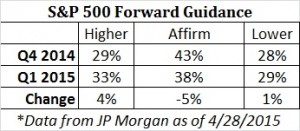
Capital Markets Update – Week of 04/27/2015
Market Overview
Sources: Rates Data and Economic Calendar—Bloomberg Markets as of 4/27/15; Equity Market, Fixed Income and REIT returns from JP Morgan as of 4/24/15.
Happening Now
Earnings Season met with Stock Gains
Earnings season in the U.S. is underway and stocks posted positive returns last week across the board with the S&P 500 index returning 1.8%, the S&P 400 Mid-cap index returning 1.2%, and the Russell 2000 index posting a gain of 1.3%. Internationally, developed markets, as measured by the MSCI EAFE index, returned 2.1% and emerging markets, as measured by the MSCI EM index, returned 1.8%, both in U.S. Dollars. In terms of year-to-date performance, small-cap growth stocks, which historically perform best during periods of economic expansion, have posted the strongest gains across the Morningstar style boxes, with a gain of 8.6%. On the opposite side of the spectrum, the weakest gains have been observed in large-cap value stocks, where investors have earned only 1.2% so far in 2015. While there are many reasons for this difference, one potential reason is that small cap stocks, as a group, tend to rely less upon revenue earned overseas. This, in turn, helps to isolate them from the losses associated with weaker international economies along with the conversion of foreign currencies into a now stronger U.S. Dollar.
In terms of Q1 earnings season, according to JP Morgan, 38% of companies in the S&P 500 index have reported results. 76% of these companies have beaten EPS estimates by an average of 7%. This was largely expected as some analysts lowered forecasts in the face of a stronger dollar. However, it is interesting to see that in terms of year-over-year performance, EPS is up 6% relative to Q1 2014. This EPS growth of 6% represents actual growth in earnings, which is significant, considering growth relative to analyst expectations is as much an expression of the inaccuracy of the analysts’ projections as it is a statement about the increased (or decreased) profitability of the firm.
In terms of forward guidance, below is a table that summarizes the percent of companies in the S&P 500 index to raise, affirm or lower their forward guidance for earnings in 2015 as of both the end of Q4 2014 and Q1 2015:

Interestingly, the largest difference is in the number of firms increasing forward guidance.
Important Information and Disclaimers
Past Performance is not a guarantee of future performance.
Investing in foreign securities presents certain risks not associated with domestic investments, such as currency fluctuation, political and economic instability, and different accounting standards. This may result in greater share price volatility. These risks are heightened in emerging markets.
There are special risks associated with an investment in real estate, including credit risk, interest rate fluctuations and the impact of varied economic conditions. Distributions from REIT investments are taxed at the owner’s tax bracket.
The prices of small company and mid cap stocks are generally more volatile than large company stocks. They often involve higher risks because smaller companies may lack the management expertise, financial resources, product diversification and competitive strengths to endure adverse economic conditions.
Investing in commodities is not suitable for all investors. Exposure to the commodities markets may subject an investment to greater share price volatility than an investment in traditional equity or debt securities. Investments in commodities may be affected by changes in overall market movements, commodity index volatility, changes in interest rates or factors affecting a particular industry or commodity.
Products that invest in commodities may employ more complex strategies which may expose investors to additional risks.
Investing in fixed income securities involves certain risks such as market risk if sold prior to maturity and credit risk especially if investing in high yield bonds, which have lower ratings and are subject to greater volatility. All fixed income investments may be worth less than original cost upon redemption or maturity. Bond Prices fluctuate inversely to changes in interest rates. Therefore, a general rise in interest rates can result in the decline of the value of your investment.
Definitions
MSCI- EAFE: The Morgan Stanley Capital International Europe, Australasia and Far East Index, a free float-adjusted market capitalization index that is designed to measure developed-market equity performance, excluding the United States and Canada.
MSCI-Emerging Markets: The Morgan Stanley Capital International Emerging Market Index, is a free float-adjusted market capitalization index that is designed to measure the performance of global emerging markets of about 25 emerging economies.
Russell 3000: The Russell 3000 measures the performance of the 3000 largest US companies based on total market capitalization and represents about 98% of the investible US Equity market.
ML BOFA US Corp Mstr [Merill Lynch US Corporate Master]: The Merrill Lynch Corporate Master Market Index is a statistical composite tracking the performance of the entire US corporate bond market over time.
ML Muni Master [Merill Lynch US Corporate Master]: The Merrill Lynch Municipal Bond Master Index is a broad measure of the municipal fixed income market.
Investors cannot directly purchase any index.
LIBOR, London Interbank Offered Rate, is the rate of interest at which banks offer to lend money to one another in the wholesale money markets in London.
The Dow Jones Industrial Average is an unweighted index of 30 “blue-chip” industrial U.S. stocks.
The S&P Midcap 400 Index is a capitalization-weighted index measuring the performance of the mid-range sector of the U.S. stock market, and represents approximately 7% of the total market value of U.S. equities. Companies in the Index fall between S&P 500 Index and the S&P SmallCap 600 Index in size: between $1-4 billion.
DJ Equity REIT Index represents all publicly traded real estate investment trusts in the Dow Jones U.S. stock universe classified as Equity REITs according to the S&P Dow Jones Indices REIT Industry Classification Hierarchy. These companies are REITSs that primarily own and operate income-producing real estate.




